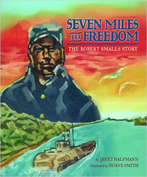Last week, I shared with you the story of Robert Smalls, who made a daring escape from freedom by stealing a boat in Charleston Harbor. The story is exciting and highlights the lengths to which some slaves would go to secure their freedom.
Seven Miles to Freedom tells the story of Robert Smalls from his birth though the successful escape in a format illustrated with beautiful impressionistic paintings. The story starts off with the author drawing the biographical background of Robert’s life on the McKee plantation in Beaufort, South Carolina. Robert tells of the horrors of slavery that he sees on other plantations, but proclaims his master to be good and fair and himself to be treated well. But his personal experience doesn’t temper his hated of slavery. Halfmann introduces us to Hannah, whom Robert falls in love with and marries. The two are lucky in that their masters allow them to live together. When Robert and Hannah’s daughter is born, the two are able to negotiate with Mr. Kingman, Hannah’s owner, for the eventual purchase price of Hannah and their daughter for a sum of $800. To help the couple earn the money, both Mr. Kingman and Robert’s owner, Mr. McKee, allowed them to hire themselves out, and keep all of their earnings but $15 a week paid to Mr. McKee and $7 a week paid to Mr. Kingman. On the verge of having enough to earn his wife’s and daughter’s freedom, the Civil War erupts in nearby Charleston Harbor. Robert reluctantly becomes part of the Confederate war effort as the ship he is the wheelman on, the Planter, is enlisted by the Confederate government to strengthen the harbor defenses by laying mines and destroying lighthouses. One evening, the white crew prepared to leave the boat. Before they left, they jokingly place the captain’s distinctive straw hat on Robert’s head. The simple act is the inspiration for Robert’s daring escape attempt. Halfmann describes the plan. On the next night that the white crew leaves, they will take the boat, pick up their loved ones, and sail out to the Union blockade, with Robert posing as the ship’s captain, straw hat and all. If they are caught, everyone agrees they will sink the boat and if the process takes too long, they will hold hands and jump overboard to drown themselves. They refuse to go back to a life of bondage. Halfmann’s strength is in the narration of the escape attempt. The rather slow and ordinary beginning of the book hits its stride when Robert’s plan is executed. I am always impressed by authors who are able to achieve suspense when its readers know (or can easily find out ) how the story actually ends. Halfmann succeeds here, creating a “hold your breath” moment as Robert slides the ship past Fort Sumter as the sun rises and his cover could be blown. This book works on several levels. First, it is an engaging story on the surface. Who doesn’t love a good, suspenseful escape from bondage story that allows you to cheer at the end? Second, for older children, the way Halfmann writes provides great opportunities to discuss the meaning of freedom:
There is some rather archaic language, as the author chooses to use the word “colored” on several occasions. This can be a bit of a shock for a book published in 2008. And I take a bit of exception to the idea that Robert knew, in 1861 , that a Union victory in the Civil War meant the abolition of slavery. At that time in the war, that conclusion could not be drawn, as the federal government was fighting for Union. Lincoln, after issuing the preliminary Emancipation Proclamation in September of 1862, used the carrot of retained slavery to entice the recalcitrant Confederate states back into the Union before the Emancipation Proclamation took effect on January 1, 1863. Had any slave state chosen to return to the Union prior to that date, slavery would have been protected as it continued to be in the Union-loyal slave holding border states.
0 Comments
Leave a Reply. |
AuthorToni is a wife, mom and history buff who loves bringing the Civil War to life for family members of all ages. Archives
July 2018
Categories
All
|

 RSS Feed
RSS Feed